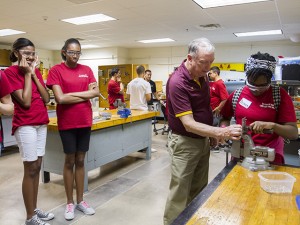
ACE Academy brings young students to ASU’s aviation program

Students in the Aviation Career Education (ACE) Academy used flight simulators at the Fulton Schools of Engineering on Arizona State University’s Polytechnic campus. Photographer: Jessica Hochreiter/ASU
About 20 middle- and high-school students from the Phoenix area, participants in of the Aviation Career Education (ACE) Academy, used flight simulators, learned about piston engines and even used riveters on a recent visit to the aviation program at the Ira A. Fulton Schools of Engineering at Arizona State University.
The ACE Academy is sponsored by the Archer Ragsdale Arizona Chapter of the Tuskegee Airmen, Inc., and the Organization of Black Aerospace Professionals.
The campus tour, hosted annually by ASU, was facilitated by Jim Anderson, a senior research scientist in the School for the Engineering of Matter, Transport and Energy, and a retired Southwest Airlines captain.
“We want to expose the young students to college education,” said Larry “Jet” Jackson, director of the Academy, who had a 20-year career as a fighter pilot in the U.S. Air Force and is now a captain for Southwest Airlines. Jackson and Anderson knew each in the Air Force, and regularly share their experiences with youth.
“Aviation is just the hook,” Jackson said. “Some of the students may be interested in aviation, others may not be. We want to encourage them in the STEM areas: science, technology, engineering and math.”
Earlier in the day, the students visited Southwest Airlines at Sky Harbor Airport where they saw a Boeing 737 up close, and learned job interviewing skills and airline operations. They also visited Luke Air Force Base to see the military side of aviation and military life. The ACE program culminated with Young Eagles flights provided by the Experimental Aircraft Association at Glendale Airport.
Later in the year, the students will take a flight aboard Sky Harbor’s 161st Air Refueling Wing’s KC-135 tanker aircraft to observe inflight refueling of F-16s.

Professor Jimmy Kimberly, a lecturer in ASU’s aviation program, shows students in the ACE Academy how to rivet two pieces of metal together. Photographer: Jessica Hochreiter/ASU
During the Academy activities, students also met African-American pioneers in the field of aviation, including Lt. Col. Robert Ashby, the first black captain for Frontier Airlines and one of the Original Tuskegee Airmen.
The Tuskegee Airmen, the first African-American pilots in the U.S. armed forces, began serving in the U.S. Army Air Corps when the military still was segregated and many states still had Jim Crow laws. Their exemplary service helped pave the way for the desegregation of the military in 1948, eventually opening the doors for minorities and women in commercial aviation many years later.
Students also met Col. Richard Toliver and Capt. William Norwood, both trailblazers. Toliver flew 231 combat missions in Southeast Asia during the Vietnam War, and was among the first pilots to fly the F-15. Norwood was a B-52 pilot in the U.S. Air Force before becoming the first black pilot hired by United Airlines, where he flew for 30 years. Ashby, Toliver and Norwood are all members of the Archer Ragsdale Arizona Chapter.
During the ASU visit, professor Jimmy Kimberly demonstrated how piston engines work and had students calculate engine power, using a formula he provided.
“For many of the students, this is the first time they’ve seen anything like this,” Jackson said. “They have no idea what’s under the hood of a car or inside a jet engine. Seeing things in a book is one thing, seeing them in a classroom or lab means a heck of a lot more.”
In a nearby lab, Anderson demonstrated how a gyroscope works, using a bicycle tire on a loop of rope. Students also used a riveting gun to put two pieces of metal together.
Nick Pagorin, 14, who will be a ninth-grader at Chaparral High School in Scottsdale in the fall, said he wants to be in naval aviation.
“I’m thinking of going to Embry-Riddle (Aeronautical University),” said Pagorin, whose father, a pilot for Omini Air International, accompanied the group to ASU.
Jonathan Nash, 13, who will be an eighth-grader at Cotton Boll Elementary School in Peoria, had never flown in a plane or seen one on the ground before participating in the Academy program.
“I want to be a safety director in the Air Force,” Nash said. “I want to travel the world. I like the science behind aviation. And I like the idea of climbing up into the sky and seeing the scenery from up there.”
Media contact
Judy Nichols, [email protected]
480-965-9248
Ira A. Fulton Schools of Engineering



































